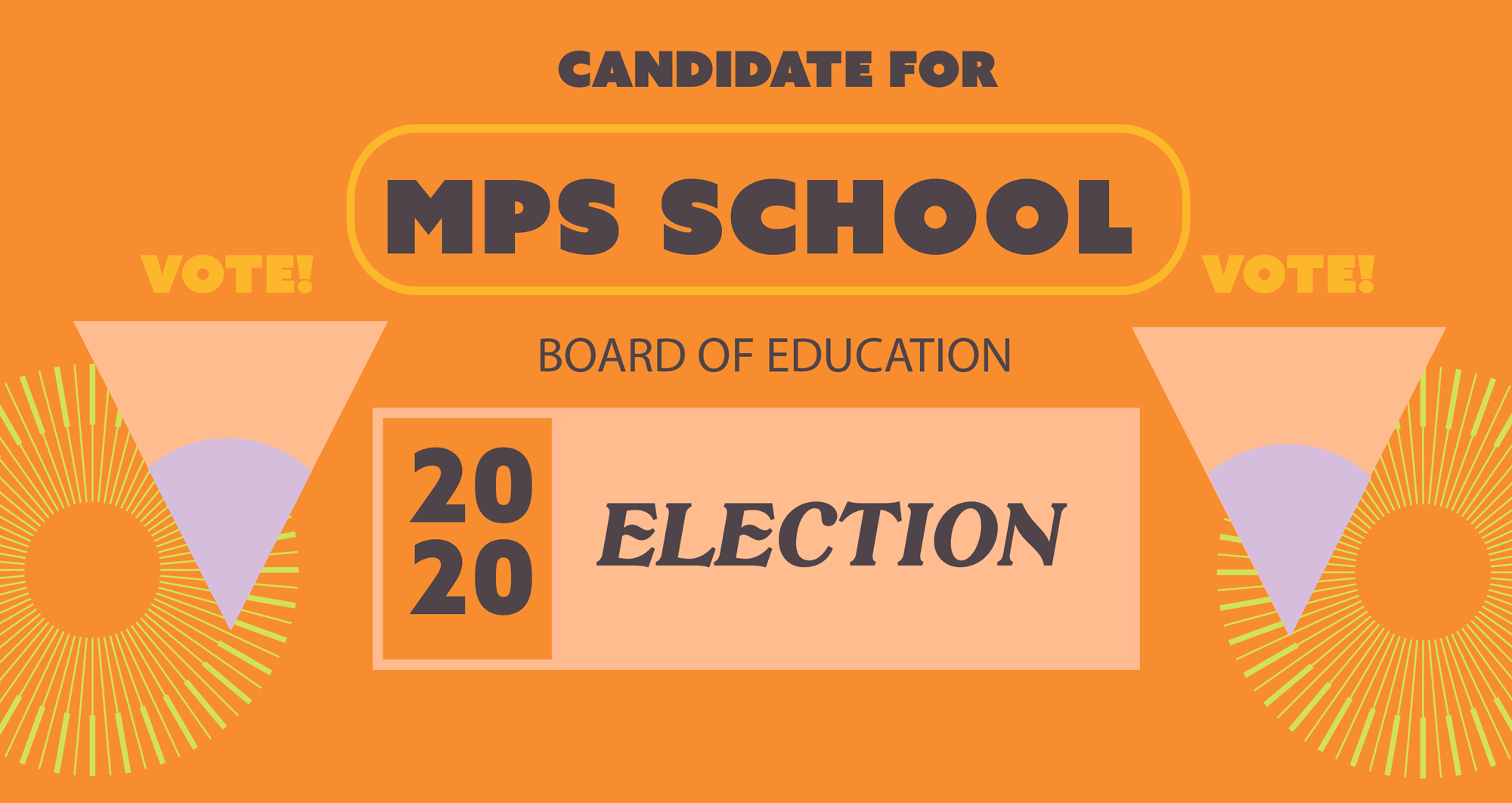



Why are you running for the Minneapolis Board of Education now?

I am passionate about addressing the achievement gap and a firm believer that building relationships with students is key to their success. All students deserve access to a well-rounded education but, academic achievement is not limited to the classroom — I believe that healthy foods, health care, after-school programs, and enrichment opportunities need to also be supported to provide a well-rounded educational experience. I am running to ensure schools have the resources to provide a high-quality education to each student.

If elected to the board, how would you be accessible to your community (e.g., having bimonthly or quarterly meetings with the community, visiting schools, responding to emails within 24 hours, etc.)?

Now more than ever, we need to include citizen voice in our decision making. I believe it’s important to work directly with the people impacted by our decisions and, I use my role to collaborate and inspire others to act on behalf of our students.
Prior to COVID-19, I held coffee hours in local cafes to talk with folks about education. I called them Hits & Misses, and we discussed what was working and ways to improve. I meet with MPS parents at district Parent Advisory Committees (PAC), including the Black PAC, Latino PAC, Special Education Advisory Committee, Somalí PAC, Hmong PAC, District PAC and World’s Best Workforce. I connect with the Native community as a board liaison to Phillips Indian Educators (PIE) and Metro Urban Indian Directors (MUID). I also attend school meetings, plays, and concerts.
 The COVID-19 pandemic is disproportionately impacting communities of color, and societal injustices are perhaps more visible than ever before. This includes widening educational inequities that range from academic outcomes and engaging in distance learning to responses to discipline and culture. Do you think the district’s current strategic approach adequately addresses the educational inequities—inequities that the pandemic is exacerbating?
The COVID-19 pandemic is disproportionately impacting communities of color, and societal injustices are perhaps more visible than ever before. This includes widening educational inequities that range from academic outcomes and engaging in distance learning to responses to discipline and culture. Do you think the district’s current strategic approach adequately addresses the educational inequities—inequities that the pandemic is exacerbating?

First, we have to make sure that every student has access to a functional devise and reliable internet. I am pleased to hear that families are reporting a much improved experience over the what happened in the Spring, when the pandemic started.
The district’s current strategic approach has not adequately addressed educational inequities. That is why the district was recently redesigned – we want to ensure that there is a high quality school in every neighborhood, and give those schools the resources needed to address the inequities in education. Although the plan is still in the implementation phase, work that is happening, with the Climate Framework and additional counseling supports, appear to address the some of the inequities we need to eradicate.

In a recent national survey conducted by Learning Heroes, only 39% of teachers report their students come prepared for grade-level work at the beginning of the year. What’s more, most parents believe their children perform at or above grade-level, because they typically rely on only one measure of achievement—report card grades.
However, many large school districts and U.S. cities are using multi-measure school performance frameworks to define, measure, and manage school quality, communicate information on school quality to families, and guide decision-making. These frameworks provide information on school performance across a variety of academic and non-academic measures to support transparent, equitable decisions, and identification of school improvement strategies.
Do you think Minneapolis should adopt a multi-measure school performance framework that aggregates data into a single rating—including academic proficiency and growth data, but also broader measures of a school’s performance (e.g., student attendance and retention data, social-emotional data, discipline data, and information on teacher and school leader diversity and retention of those educators)? Why or why not?

Maybe not formally, but I believe Minneapolis is already doing this. Our staff have attendance, retention, SEL, growth and proficiency data and they use it when making decisions about funding and training.
In addition, at Parent-Teacher Conferences, parents are encouraged to ask teachers if the teacher believes a standardized test score is indicative of the child’s ability. Our schools have these answers and they are doing their best to communicate it to the parents.
I do, however, wonder if this is a way the State could report on school performance, instead of just using MCA scores.
 In recent years, the Minneapolis district has made new investments to meet students’ social-emotional needs. What goals or measures do you think the board should use to ensure this work is producing positive outcomes for students? How would you hold the district accountable for meeting social-emotional goals?
In recent years, the Minneapolis district has made new investments to meet students’ social-emotional needs. What goals or measures do you think the board should use to ensure this work is producing positive outcomes for students? How would you hold the district accountable for meeting social-emotional goals?

When the Collaborative for Academic Social and Emotional Learning (CASEL) visited the district to explain Social and Emotional Learning, it sounded very similar to the work we did when I taught at GAP School. But, we didn’t call it SEL; we called it relationships and we didn’t measure it. However, I did notice students more engaged in their learning, attendance improved, students were more willing to accept leadership roles, they became more involved in after school activities and, they graduated.
So, I suppose some goals I would expect to see are improved attendance and higher graduation rates. Our Research & Evaluation Department will likely be able to measure levels of engagement, acceptance, and belonging. But, it might be enough for me if students are feeling seen and valued.

Following the Minneapolis Board of Education’s approval of the Comprehensive District Design in May 2020, what results do you believe will be important to track to ensure the CDD implementation is grounded in equity?

Right away, the district will be able to evaluate how well schools are integrated and which students are receiving high quality teaching. These are two important indicators that can tell us how equitably our resources are being used.
Throughout the first year and beyond, we should track whether curriculum reflects our students lived experiences and, who has access to rigorous coursework.
We should continuously look at what the data is telling us about discipline, attendance, graduation rates to evaluate how effective our interventions are working.

Across our community, many schools of all types (geography, grades, programs, sectors) enroll especially large numbers of students from a low-income background. Across these schools we see dramatically different results (with similar student populations), including, for example, the number of students reading and doing math on grade level and, for high schools, graduation rates and college persistence. In large U.S. cities that are effectively closing opportunity gaps and have great, high-functioning schools, districts use a myriad of tools to address low-performing schools that aren’t working for kids and families.
What do you think are appropriate solutions for addressing chronically low-performing schools? From the solutions below, please identify three you would advocate for and see the Minneapolis Board of Education able to affect:
— Equitable allocation of resources—financial and/or access to highly effective teaching
— Significant school redesign, including new model and new staffing at all levels
— School leadership change
— Additional programming
— Enrollment flexibility for students zoned to that school
— School closure
— Other [insert solutions]:
Please explain your selections. What quantifiable outcomes do you believe the board should use to determine if disparities are shrinking?

I place the teacher at the top of the list when exploring how well a student will achieve. While this is a staffing issue that lies outside of the board’s work, we can ensure that the funding is available to attract and retain effective teachers at our more struggling schools.
I chose the second solution because I believe some of our schools will be significantly redesigned when the Comprehensive District Design is implemented. Although staffing may stay consistent, programs can shift. And, there will be ample opportunities to make major changes to address the needs of the school community.
I chose School Leadership Change because, from my personal experience, a strong leader can create highly effective teachers. Since the board’s only employee is the superintendent, we would have to evaluate the superintendent on the effective of the leaders.
To determine if these strategies are working, the Board should use the same data that shows the disparities exist — discipline, graduation, attendance, to name a few.
 As the state of Minnesota permits open enrollment and the formation of charter schools—publicly funded schools that are governed by a nonprofit board of directors and a state-approved authorizer, but not by a local school board—large numbers of families of color in Minneapolis have enrolled their children in neighboring district schools and/or public charter schools.
As the state of Minnesota permits open enrollment and the formation of charter schools—publicly funded schools that are governed by a nonprofit board of directors and a state-approved authorizer, but not by a local school board—large numbers of families of color in Minneapolis have enrolled their children in neighboring district schools and/or public charter schools.
What are your thoughts on the above dynamic? How do you think about the role that charter schools play in the K-12 ecosystem?

Right now, I am hyper-focused on district public schools, in Minneapolis, as well as around the State and in the metro area, so I have not evaluated the ecosystem of schools. However, it is every parent’s right to choose a school that best fits their family’s needs best. If a different choice provides children with a better academic experience and higher proficiency, it might be a better choice. I don’t believe, though, that’s always the case.
I’ll admit that I may be biased in my opinion, but I believe that district schools have the knowledge and relationships to add additional supports to student’s needs that aren’t being addressed in the school.
 One of the four critical responsibilities of a school board is to hire and evaluate the superintendent. What 3-5 quantifiable outcomes do you think are the most important to include as part of the board’s evaluation of the superintendent’s performance?
One of the four critical responsibilities of a school board is to hire and evaluate the superintendent. What 3-5 quantifiable outcomes do you think are the most important to include as part of the board’s evaluation of the superintendent’s performance?

The board should evaluate the superintendent on how well students are achieving, his ability to recruit and retain teachers, the CDDs communication and implementation effectiveness.
 What public or private organizations have endorsed you and/or contributed to your campaign?
What public or private organizations have endorsed you and/or contributed to your campaign?

The DFL has endorsed me and I am also endorsed by WomenWinning. The rest of my endorsements are from people – those who hold elected office are listed on my website.
We invite you to expand on answers to any of the questions in the survey:

Nothing to add.
Candidate Information
Office Sought: Minneapolis School Board – At-Large (citywide)
Preferred pronouns: she/her/hers
Website: kimellisonforschools.com
Candidate’s Twitter handle: @KimEllison
Campaign or candidate’s Facebook page: facebook.com/EllisonforMplsSchoolAtLarge

Meet the other candidates running for MPS School Board.
Click here for more information on how and where to vote.